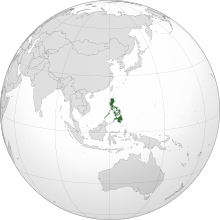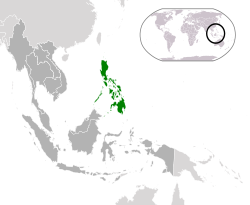
A | B | C | D | E | F | G | H | CH | I | J | K | L | M | N | O | P | Q | R | S | T | U | V | W | X | Y | Z | 0 | 1 | 2 | 3 | 4 | 5 | 6 | 7 | 8 | 9
Republic of the Philippines Republika ng Pilipinas (Filipino) | |
|---|---|
| Motto: Maka-Diyos, Maka-tao, Makakalikasan at Makabansa[1] "For God, People, Nature, and Country" | |
| Anthem: "Lupang Hinirang" "Chosen Land" | |
| Capital | Manila (de jure) Metro Manila[a] (de facto) |
| Largest city | Quezon City |
| Official languages | |
| Recognized regional languages | 19 languages[4] |
National sign language | Filipino Sign Language |
Other recognized languages[b] | Spanish and Arabic |
| Ethnic groups (2020[6]) | |
| Religion (2020)[7] |
|
| Demonym(s) | Filipino (neutral) Filipina (feminine) Pinoy (adjective for certain common nouns) |
| Government | Unitary presidential republic |
| Bongbong Marcos | |
| Sara Duterte | |
| Francis Escudero | |
| Martin Romualdez | |
| Alexander Gesmundo | |
| Legislature | Congress |
| Senate | |
| House of Representatives | |
| Independence from Spain and the United States | |
| June 12, 1898 | |
• Cession | December 10, 1898 |
| November 15, 1935 | |
| July 4, 1946 | |
| February 2, 1987 | |
| Area | |
• Total | 300,000[8][9][d] km2 (120,000 sq mi) (64th) |
• Water (%) | 0.61[10] (inland waters) |
| Population | |
• 2024 estimate | |
• 2020 census | |
• Density | 363.45/km2 (941.3/sq mi) (37th) |
| GDP (PPP) | 2024 estimate |
• Total | |
• Per capita | |
| GDP (nominal) | 2024 estimate |
• Total | |
• Per capita | |
| Gini (2021) | medium |
| HDI (2022) | high (113th) |
| Currency | Philippine peso (₱) (PHP) |
| Time zone | UTC+08:00 (PhST) |
| Driving side | right[16] |
| Calling code | +63 |
| ISO 3166 code | PH |
| Internet TLD | .ph |
The Philippines,[e] officially the Republic of the Philippines,[f] is an archipelagic country in Southeast Asia. In the western Pacific Ocean, it consists of 7,641 islands, with a total area of 300,000 square kilometers,[17] which are broadly categorized in three main geographical divisions from north to south: Luzon, Visayas, and Mindanao. The Philippines is bounded by the South China Sea to the west, the Philippine Sea to the east, and the Celebes Sea to the south. It shares maritime borders with Taiwan to the north, Japan to the northeast, Palau to the east and southeast, Indonesia to the south, Malaysia to the southwest, Vietnam to the west, and China to the northwest. It is the world's twelfth-most-populous country, with diverse ethnicities and cultures. Manila is the country's capital, and its most populated city is Quezon City. Both are within Metro Manila.
Negritos, the archipelago's earliest inhabitants, were followed by waves of Austronesian peoples. The adoption of animism, Hinduism with Buddhist influence, and Islam established island-kingdoms ruled by datus, rajas, and sultans. Extensive overseas trade with neighbors such as the late Tang or Song empire brought Chinese people to the archipelago as well, which would also gradually settle in and intermix over the centuries. The arrival of Ferdinand Magellan, a Portuguese explorer leading a fleet for Castile, marked the beginning of Spanish colonization. In 1543, Spanish explorer Ruy López de Villalobos named the archipelago Las Islas Filipinas in honor of King Philip II of Castile. Spanish colonization via New Spain, beginning in 1565, led to the Philippines becoming ruled by the Crown of Castile, as part of the Spanish Empire, for more than 300 years. Catholic Christianity became the dominant religion, and Manila became the western hub of trans-Pacific trade. Hispanic immigrants from Latin America and Iberia would also selectively colonize. The Philippine Revolution began in 1896, and became entwined with the 1898 Spanish–American War. Spain ceded the territory to the United States, and Filipino revolutionaries declared the First Philippine Republic. The ensuing Philippine–American War ended with the United States controlling the territory until the Japanese invasion of the islands during World War II. After the United States retook the Philippines from the Japanese, the Philippines became independent in 1946. The country has had a tumultuous experience with democracy, which included the overthrow of a decades-long dictatorship in a nonviolent revolution.
The Philippines is an emerging market and a newly industrialized country, whose economy is transitioning from being agricultural to service- and manufacturing-centered. It is a founding member of the United Nations, the World Trade Organization, ASEAN, the Asia-Pacific Economic Cooperation forum, and the East Asia Summit; it is a member of the Non-Aligned Movement and a major non-NATO ally of the United States. Its location as an island country on the Pacific Ring of Fire and close to the equator makes it prone to earthquakes and typhoons. The Philippines has a variety of natural resources and a globally-significant level of biodiversity.
Etymology
During his 1542 expedition, Spanish explorer Ruy López de Villalobos named the islands of Leyte and Samar "Felipinas" after King Philip II of Castile (then Prince of Asturias). Eventually, the name "Las Islas Filipinas" would be used for the archipelago's Spanish possessions.[18]: 6 Other names, such as "Islas del Poniente" (Western Islands), "Islas del Oriente" (Eastern Islands), Ferdinand Magellan's name, and "San Lázaro" (Islands of St. Lazarus), were used by the Spanish to refer to islands in the region before Spanish rule was established.[19][20][21]
During the Philippine Revolution, the Malolos Congress proclaimed it the República Filipina (the Philippine Republic).[22] American colonial authorities referred to the country as the Philippine Islands (a translation of the Spanish name).[23] The United States began changing its nomenclature from "the Philippine Islands" to "the Philippines" in the Philippine Autonomy Act and the Jones Law.[24] The official title "Republic of the Philippines" was included in the 1935 constitution as the name of the future independent state,[25] and in all succeeding constitutional revisions.[26][27]
History
Prehistory (pre–900)
There is evidence of early hominins living in what is now the Philippines as early as 709,000 years ago.[28] A small number of bones from Callao Cave potentially represent an otherwise unknown species, Homo luzonensis, who lived 50,000 to 67,000 years ago.[29][30] The oldest modern human remains on the islands are from the Tabon Caves of Palawan, U/Th-dated to 47,000 ± 11–10,000 years ago.[31] Tabon Man is presumably a Negrito, among the archipelago's earliest inhabitants descended from the first human migrations out of Africa via the coastal route along southern Asia to the now-sunken landmasses of Sundaland and Sahul.[32]
The first Austronesians reached the Philippines from Taiwan around 2200 BC, settling the Batanes Islands (where they built stone fortresses known as ijangs)[33] and northern Luzon. Jade artifacts have been dated to 2000 BC,[34][35] with lingling-o jade items made in Luzon with raw materials from Taiwan.[36] By 1000 BC, the inhabitants of the archipelago had developed into four societies: hunter-gatherer tribes, warrior societies, highland plutocracies, and port principalities.[37]
Early states (900–1565)
The earliest known surviving written record in the Philippines is the early-10th-century AD Laguna Copperplate Inscription, which was written in Old Malay using the early Kawi script with a number of technical Sanskrit words and Old Javanese or Old Tagalog honorifics.[38] By the 14th century, several large coastal settlements emerged as trading centers and became the focus of societal changes.[39] Some polities had exchanges with other states throughout Asia.[40]: 3 [41] Trade with China is believed to have begun during the late Tang dynasty,[42][43] and expanded during the Song dynasty.[44][45][43] Throughout the second millennium AD, some polities were also part of the tributary system of China.[18]: 177–178 [40]: 3 With extensive trade and diplomacy, this also brought Southern Chinese merchants and migrants especially from Southern Fujian, historically initially known in Tagalog as "Langlang"[46] and "Sanglay"[47] and later in Spanish as "Sangley",[48] which over the centuries would also gradually settle and intermix in the Philippines. Indian cultural traits such as linguistic terms and religious practices began to spread in the Philippines during the 14th century, probably via the Hindu Majapahit Empire.[49][50] By the 15th century, Islam was established in the Sulu Archipelago and spread from there.[39]
Polities founded in the Philippines between the 10th and 16th centuries include Maynila,[51] Tondo, Namayan, Pangasinan, Cebu, Butuan, Maguindanao, Lanao, Sulu, and Ma-i.[52] The early polities typically had a three-tier social structure: nobility, freemen, and dependent debtor-bondsmen.[40]: 3 [53]: 672 Among the nobility were leaders known as datus, who were responsible for ruling autonomous groups (barangays or dulohan).[54] When the barangays banded together to form a larger settlement or a geographically looser alliance,[40]: 3 [55] their more-esteemed members would be recognized as a "paramount datu",[56]: 58 [37] rajah or sultan,[57] and would rule the community.[58] Population density is thought to have been low during the 14th to 16th centuries[56]: 18 due to the frequency of typhoons and the Philippines' location on the Pacific Ring of Fire.[59] Portuguese explorer Ferdinand Magellan arrived in 1521, claimed the islands for Spain, and was killed by Lapulapu's men in the Battle of Mactan.[60]: 21 [61]: 261
Spanish and American colonial rule (1565–1934)

Unification and colonization by the Crown of Castile began when Spanish explorer Miguel López de Legazpi arrived from New Spain (Spanish: Nueva España) in 1565.[62][63][64]: 20–23 Many Filipinos were brought to New Spain as slaves and forced crew.[65] Spanish Manila became the capital of the Spanish East Indies in 1571,[66][67] Spanish territories in Asia and the Pacific.[68] The Spanish invaded local states using the principle of divide and conquer,[61]: 374 bringing most of what is the present-day Philippines under one unified administration.[69][70] Disparate barangays were deliberately consolidated into towns, where Catholic missionaries could more easily convert their inhabitants to Christianity,[71]: 53, 68 [72] which was initially Syncretist.[73] Christianization by the Spanish friars occurred mostly across the settled lowlands over the centuries, whether be it the Austronesian[74] groups or even the Sangley Chinese[75][76] migrant settlers and any mixed mestizo descendants thereof. From 1565 to 1821, the Philippines was governed as a territory of the Mexico City-based Viceroyalty of New Spain; it was then administered from Madrid after the Mexican War of Independence.[77]: 81 Manila became the western hub of trans-Pacific trade[78] by Manila galleons built in Bicol and Cavite.[79][80]
During its rule, Spain nearly bankrupted its treasury quelling indigenous revolts[77]: 111–122 and defending against external military attacks,[81]: 1077 [82] including Moro piracy,[83] a 17th-century war against the Dutch, 18th-century British occupation of Manila, and conflict with Muslims in the south.[84]: 4 [undue weight? – discuss]
Administration of the Philippines was considered a drain on the economy of New Spain,[81]: 1077 and abandoning it or trading it for other territory was debated. This course of action was opposed because of the islands' economic potential, security, and the desire to continue religious conversion in the region.[56]: 7–8 [85] The colony survived on an annual subsidy from the Spanish crown[81]: 1077 averaging 250,000 pesos,[56]: 8 usually paid as 75 tons of silver bullion from the Americas.[86] British forces occupied Manila from 1762 to 1764 during the Seven Years' War, and Spanish rule was restored with the 1763 Treaty of Paris.[64]: 81–83 The Spanish considered their war with the Muslims in Southeast Asia an extension of the Reconquista.[87][88] The Spanish–Moro conflict lasted for several hundred years; Spain conquered portions of Mindanao and Jolo during the last quarter of the 19th century,[89] and the Muslim Moro in the Sultanate of Sulu acknowledged Spanish sovereignty.[90][91]

Philippine ports opened to world trade during the 19th century, and Filipino society began to change.[92][93] Social identity changed, with the term Filipino encompassing all residents of the archipelago instead of solely referring to Spaniards born in the Philippines.[94][95]
Revolutionary sentiment grew in 1872 after three activist Catholic priests were executed on questionable grounds.[96][97] This inspired the Propaganda Movement, organized by Marcelo H. del Pilar, José Rizal, Graciano López Jaena, and Mariano Ponce, which advocated political reform in the Philippines.[98] Rizal was executed on December 30, 1896, for rebellion, and his death radicalized many who had been loyal to Spain.[99] Attempts at reform met with resistance; Andrés Bonifacio founded the Katipunan secret society, which sought independence from Spain through armed revolt, in 1892.[77]: 137
The Katipunan Cry of Pugad Lawin began the Philippine Revolution in 1896.[100] Internal disputes led to the Tejeros Convention, at which Bonifacio lost his position and Emilio Aguinaldo was elected the new leader of the revolution.[101]: 145–147 The 1897 Pact of Biak-na-Bato resulted in the Hong Kong Junta government in exile. The Spanish–American War began the following year, and reached the Philippines; Aguinaldo returned, resumed the revolution, and declared independence from Spain on June 12, 1898.[102]: 26 In December 1898, the islands were ceded by Spain to the United States with Puerto Rico and Guam after the Spanish–American War.[103][104]
The First Philippine Republic was promulgated on January 21, 1899.[105] Lack of recognition by the United States led to an outbreak of hostilities that, after refusal by the U.S. on-scene military commander of a cease-fire proposal and a declaration of war by the nascent Republic,[g] escalated into the Philippine–American War.[106][107][108][109]
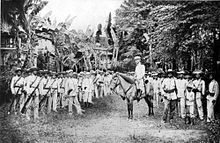
The war resulted in the deaths of 250,000 to 1 million civilians, primarily due to famine and disease.[110] Many Filipinos were transported by the Americans to concentration camps, where thousands died.[111][112] After the fall of the First Philippine Republic in 1902, an American civilian government was established with the Philippine Organic Act.[113] American forces continued to secure and extend their control of the islands, suppressing an attempted extension of the Philippine Republic,[101]: 200–202 [110] securing the Sultanate of Sulu,[114][115] establishing control of interior mountainous areas which had resisted Spanish conquest,[116] and encouraging large-scale resettlement of Christians in once-predominantly-Muslim Mindanao.[117][118]

Commonwealth and World War II (1935–1946)
Cultural developments in the Philippines strengthened a national identity,[119][120]: 12 and Tagalog began to take precedence over other local languages.[71]: 121 Governmental functions were gradually given to Filipinos by the Taft Commission;[81]: 1081, 1117 the 1934 Tydings–McDuffie Act granted a ten-year transition to independence through the creation of the Commonwealth of the Philippines the following year,[121] with Manuel Quezon president and Sergio Osmeña vice president.[122] Quezon's priorities were defence, social justice, inequality, economic diversification, and national character.[81]: 1081, 1117 Filipino (a standardized variety of Tagalog) became the national language,[123]: 27–29 women's suffrage was introduced,[124][61]: 416 and land reform was considered.[125][126][127]

The Empire of Japan invaded the Philippines in December 1941 during World War II,[128] and the Second Philippine Republic was established as a puppet state governed by Jose P. Laurel.[129][130] Beginning in 1942, the Japanese occupation of the Philippines was opposed by large-scale underground guerrilla activity.[131][132][133] Atrocities and war crimes were committed during the war, including the Bataan Death March and the Manila massacre.[134][135] The Philippine resistance and Allied troops defeated the Japanese in 1944 and 1945. Over one million Filipinos were estimated to have died by the end of the war.[136][137] On October 11, 1945, the Philippines became a founding member of the United Nations.[138][139]: 38–41 On July 4, 1946, during the presidency of Manuel Roxas, the country's independence was recognized by the United States with the Treaty of Manila.[139]: 38–41 [140]
Independence (1946–present)
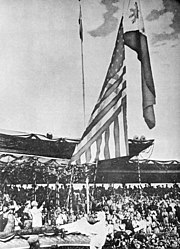
Efforts at post-war reconstruction and ending the Hukbalahap Rebellion succeeded during Ramon Magsaysay's presidency,[141] but sporadic communist insurgency continued to flare up long afterward.[142] Under Magsaysay's successor, Carlos P. Garcia, the government initiated a Filipino First policy which promoted Filipino-owned businesses.[71]: 182 Succeeding Garcia, Diosdado Macapagal moved Independence Day from July 4 to June 12—the date of Emilio Aguinaldo's declaration—[143] and pursued a claim on eastern North Borneo.[144][145]
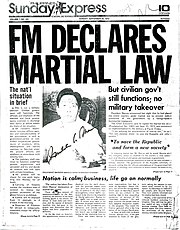
In 1965, Macapagal lost the presidential election to Ferdinand Marcos. Early in his presidency, Marcos began infrastructure projects funded mostly by foreign loans; this improved the economy, and contributed to his reelection in 1969.[146]: 58 [147] Near the end of his last constitutionally-permitted term, Marcos declared martial law on September 21, 1972[148] using the specter of communism[149][150][151] and began to rule by decree;[152] the period was characterized by political repression, censorship, and human rights violations.[153][154] Monopolies controlled by Marcos' cronies were established in key industries,[155][156][157] including logging[158] and broadcasting;[61]: 120 a sugar monopoly led to a famine on the island of Negros.[159] With his wife, Imelda, Marcos was accused of corruption and embezzling billions of dollars of public funds.[160][161] Marcos' heavy borrowing early in his presidency resulted in economic crashes, exacerbated by an early 1980s recession where the economy contracted by 7.3 percent annually in 1984 and 1985.[162]: 212 [163]
On August 21, 1983, opposition leader Benigno Aquino Jr. (Marcos' chief rival) was assassinated on the tarmac at Manila International Airport.[164] Marcos called a snap presidential election in 1986[165] which proclaimed him the winner, but the results were widely regarded as fraudulent.[166] The resulting protests led to the People Power Revolution,[167][168] which forced Marcos and his allies to flee to Hawaii. Aquino's widow, Corazon, was installed as president.[167]

The return of democracy and government reforms which began in 1986 were hampered by national debt, government corruption, and coup attempts.[170][146]: xii, xiii A communist insurgency[171][172] and military conflict with Moro separatists persisted;[173] the administration also faced a series of disasters, including the eruption of Mount Pinatubo in June 1991.[169] Aquino was succeeded by Fidel V. Ramos, who liberalized the national economy with privatization and deregulation.[174][175] Ramos' economic gains were overshadowed by the onset of the 1997 Asian financial crisis.[176][177] His successor, Joseph Estrada, prioritized public housing[178] but faced corruption allegations[179] which led to his overthrow by the 2001 EDSA Revolution and the succession of Vice President Gloria Macapagal Arroyo on January 20, 2001.[180] Arroyo's nine-year administration was marked by economic growth,[10] but was tainted by corruption and political scandals,[181][182] including electoral fraud allegations during the 2004 presidential election.[183] Economic growth continued during Benigno Aquino III's administration, which advocated good governance and transparency.[184]: 1, 3 [185] Aquino III signed a peace agreement with the Moro Islamic Liberation Front (MILF) resulting in the Bangsamoro Organic Law establishing an autonomous Bangsamoro region, but a shootout with MILF rebels in Mamasapano delayed passage of the law.[186][187]
Rodrigo Duterte, elected president in 2016,[188] launched an infrastructure program[189][190] and an anti-drug campaign[191][192] which reduced drug proliferation[193] but has also led to extrajudicial killings.[194][195] The Bangsamoro Organic Law was enacted in 2018.[196] In early 2020, the COVID-19 pandemic reached the Philippines;[197][198] its gross domestic product shrank by 9.5 percent, the country's worst annual economic performance since 1947.[199] Marcos' son, Bongbong Marcos, won the 2022 presidential election; Duterte's daughter, Sara, became vice president.[200]
Geography

The Philippines is an archipelago of about 7,641 islands,[202][203] covering a total area (including inland bodies of water) of about 300,000 square kilometers (115,831 sq mi).[17][204]: 15 [10][d] Stretching 1,850 kilometers (1,150 mi) north to south,[206] from the South China Sea to the Celebes Sea,[207] the Philippines is bordered by the Philippine Sea to the east,[208][209] and the Sulu Sea to the southwest.[210] The country's 11 largest islands are Luzon, Mindanao, Samar, Negros, Palawan, Panay, Mindoro, Leyte, Cebu, Bohol and Masbate, about 95 percent of its total land area.[211] The Philippines' coastline measures 36,289 kilometers (22,549 mi), the world's fifth-longest,[212] and the country's exclusive economic zone covers 2,263,816 km2 (874,064 sq mi).[213]
Its highest mountain is Mount Apo on Mindanao, with an altitude of 2,954 meters (9,692 ft) above sea level.[10] The Philippines' longest river is the Cagayan River in northern Luzon, which flows for about 520 kilometers (320 mi).[214] Manila Bay, on which is the capital city of Manila,[215] is connected to Laguna de Bay[216] (the country's largest lake) by the Pasig River.[217]
On the western fringes of the Pacific Ring of Fire, the Philippines has frequent seismic and volcanic activity.[218]: 4 The region is seismically active, and has been constructed by plates converging towards each other from multiple directions.[219][220] About five earthquakes are recorded daily, although most are too weak to be felt.[221] The last major earthquakes were in 1976 in the Moro Gulf and in 1990 on Luzon.[222] The Philippines has 23 active volcanoes; of them, Mayon, Taal, Canlaon, and Bulusan have the largest number of recorded eruptions.[223][204]: 26
The country has valuable[224] mineral deposits as a result of its complex geologic structure and high level of seismic activity.[225][226] It is thought to have the world's second-largest gold deposits (after South Africa), large copper deposits,[227] and the world's largest deposits of palladium.[228] Other minerals include chromium, nickel, molybdenum, platinum, and zinc.[229] However, poor management and law enforcement, opposition from indigenous communities, and past environmental damage have left these resources largely untapped.[227][230]
Biodiversity

The Philippines is a megadiverse country,[232][233] with some of the world's highest rates of discovery and endemism (67 percent).[234][235] With an estimated 13,500 plant species in the country (3,500 of which are endemic),[236] Philippine rain forests have an array of flora:[237][238] about 3,500 species of trees,[239] 8,000 flowering plant species, 1,100 ferns, and 998 orchid species[240] have been identified.[241] The Philippines has 167 terrestrial mammals (102 endemic species), 235 reptiles (160 endemic species), 99 amphibians (74 endemic species), 686 birds (224 endemic species),[242] and over 20,000 insect species.[241]
As an important part of the Coral Triangle ecoregion,[243][244] Philippine waters have unique, diverse marine life[245] and the world's greatest diversity of shore-fish species.[246] The country has over 3,200 fish species (121 endemic).[247] Philippine waters sustain the cultivation of fish, crustaceans, oysters, and seaweeds.[248][249]
Eight major types of forests are distributed throughout the Philippines: dipterocarp, beach forest,[250] pine forest, molave forest, lower montane forest, upper montane (or mossy forest), mangroves, and ultrabasic forest.[251] According to official estimates, the Philippines had 7,000,000 hectares (27,000 sq mi) of forest cover in 2023.[252] Logging had been systemized during the American colonial period[253] and deforestation continued after independence, accelerating during the Marcos presidency due to unregulated logging concessions.[254][255] Forest cover declined from 70 percent of the Philippines' total land area in 1900 to about 18.3 percent in 1999.[256] Rehabilitation efforts have had marginal success.[257]
The Philippines is a priority hotspot for biodiversity conservation;[258][232] it has more than 200 protected areas,[259] which was expanded to 7,790,000 hectares (30,100 sq mi) as of 2023[update].[260] Three sites in the Philippines have been included on the UNESCO World Heritage List: the Tubbataha Reef in the Sulu Sea,[261] the Puerto Princesa Subterranean River,[262] and the Mount Hamiguitan Wildlife Sanctuary.[263]
Climate
The Philippines has a tropical maritime climate which is usually hot and humid. There are three seasons: a hot dry season from March to May, a rainy season from June to November, and a cool dry season from December to February.[264] The southwest monsoon (known as the habagat) lasts from May to October, and the northeast monsoon (amihan) lasts from November to April.[265]: 24–25 The coolest month is January, and the warmest is May. Temperatures at sea level across the Philippines tend to be in the same range, regardless of latitude; average annual temperature is around 26.6 °C (79.9 °F) but is 18.3 °C (64.9 °F) in Baguio, 1,500 meters (4,900 ft) above sea level.[266] The country's average humidity is 82 percent.[265]: 24–25 Annual rainfall is as high as 5,000 millimeters (200 in) on the mountainous east coast, but less than 1,000 millimeters (39 in) in some sheltered valleys.[264]
The Philippine Area of Responsibility has 19 typhoons in a typical year,[267] usually from July to October;[264] eight or nine of them make landfall.[268][269] The wettest recorded typhoon to hit the Philippines dropped 2,210 millimeters (87 in) in Baguio from July 14 to 18, 1911.[270] The country is among the world's ten most vulnerable to climate change.[271][272]
Government and politics

The Philippines has a democratic government, a constitutional republic with a presidential system.[273] The president is head of state and head of government,[274] and is the commander-in-chief of the armed forces.[273] The president is elected through direct election by the citizens of the Philippines for a six-year term.[275] The president appoints and presides over the cabinet and officials of various national government agencies and institutions.[276]: 213–214 The bicameral Congress is composed of the Senate (the upper house, with members elected to a six-year term) and the House of Representatives, the lower house, with members elected to a three-year term.[277]
Senators are elected at-large,[277] and representatives are elected from legislative districts and party lists.[276]: 162–163 Judicial authority is vested in the Supreme Court, composed of a chief justice and fourteen associate justices,[278] who are appointed by the president from nominations submitted by the Judicial and Bar Council.[273]
Attempts to change the government to a federal, unicameral, or parliamentary government have been made since the Ramos administration.[279] Philippine politics tends to be dominated by well-known families, such as political dynasties or celebrities.[280][281] Corruption is significant,[282][283][284] attributed by some historians to the Spanish colonial period's padrino system.[285][286] The Roman Catholic church exerts considerable but waning[287] influence in political affairs, although a constitutional provision for the separation of Church and State exists.[288]
Foreign relations
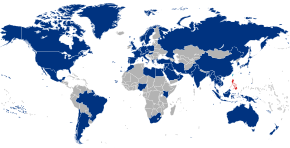
A founding and active member of the United Nations,[139]: 37–38 the Philippines has been a non-permanent member of the Security Council.[289] The country participates in peacekeeping missions, particularly in East Timor.[290][291] The Philippines is a founding and active member of ASEAN (Association of Southeast Asian Nations)[292][293] and a member of the East Asia Summit,[294] the Group of 24,[295] and the Non-Aligned Movement.[296] The country has sought to obtain observer status in the Organisation of Islamic Cooperation since 2003,[297][298] and was a member of SEATO.[299][300] Over 10 million Filipinos live and work in 200 countries,[301][302] giving the Philippines soft power.[162]: 207
During the 1990s, the Philippines began to seek economic liberalization and free trade[303]: 7–8 to help spur foreign direct investment.[304] It is a member of the World Trade Organization[303]: 8 and the Asia-Pacific Economic Cooperation.[305] The Philippines entered into the ASEAN Trade in Goods Agreement in 2010[306] and the Regional Comprehensive Economic Partnership free trade agreement (FTA) in 2023.[307][308] Through ASEAN, the Philippines has signed FTAs with China, India, Japan, South Korea, Australia and New Zealand.[303]: 15 The country has bilateral FTAs with Japan, South Korea,[309] and four European states: Iceland, Liechtenstein, Norway and Switzerland.[303]: 9–10, 15
The Philippines has a long relationship with the United States, involving economics, security, and interpersonal relations.[310] The Philippines' location serves an important role in the United States' island chain strategy in the West Pacific;[311][312] a Mutual Defense Treaty between the two countries was signed in 1951, and was supplemented with the 1999 Visiting Forces Agreement and the 2016 Enhanced Defense Cooperation Agreement.[313] The country supported American policies during the Cold War and participated in the Korean and Vietnam wars.[314][315] In 2003, the Philippines was designated a major non-NATO ally.[316] Under President Duterte, ties with the United States weakened in favor of improved relations with China and Russia.[317][318][319] The Philippines relies heavily on the United States for its external defense;[184]: 11 the U.S. has made regular assurances to defend the Philippines,[320] including the South China Sea.[321]
Since 1975, the Philippines has valued its relations with China[322]—its top trading partner,[323] and cooperates significantly with the country.[324][317] Japan is the biggest bilateral contributor of official development assistance to the Philippines;[325][326] although some tension exists because of World War II, much animosity has faded.[84]: 93 Historical and cultural ties continue to affect relations with Spain.[327][328] Relations with Middle Eastern countries are shaped by the high number of Filipinos working in those countries,[329] and by issues related to the Muslim minority in the Philippines;[330] concerns have been raised about domestic abuse and war affecting[331] the approximately 2.5 million overseas Filipino workers in the region.[332]
The Philippines has claims in the Spratly Islands which overlap with claims by China, Malaysia, Taiwan, and Vietnam.[333] The largest of its controlled islands is Thitu Island, which contains the Philippines' smallest town.[334] The 2012 Scarborough Shoal standoff, after China seized the shoal from the Philippines, led to an international arbitration case[335] which the Philippines eventually won;[336] China rejected the result,[337] and made the shoal a prominent symbol of the broader dispute.[338]
Military
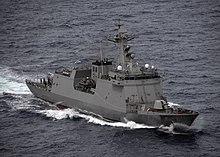
The volunteer Armed Forces of the Philippines (AFP) consist of three branches: the Philippine Air Force, the Philippine Army, and the Philippine Navy.[339][340] Civilian security is handled by the Philippine National Police under the Department of the Interior and Local Government.[341] The AFP had a total manpower of around 280,000 as of 2022[update], of which 130,000 were active military personnel, 100,000 were reserves, and 50,000 were paramilitaries.[342]
In 2021, $4,090,500,000 (1.04 percent of GDP) was spent on the Philippine military.[343][344] Most of the country's defense spending is on the Philippine Army, which leads operations against internal threats such as communist and Muslim separatist insurgencies; its preoccupation with internal security contributed to the decline of Philippine naval capability which began during the 1970s.[345] A military modernization program began in 1995[346] and expanded in 2012 to build a more capable defense system.[347]
The Philippines has long struggled against local insurgencies, separatism, and terrorism.[348][349][350] Bangsamoro's largest separatist organizations, the Moro National Liberation Front and the Moro Islamic Liberation Front, signed final peace agreements with the government in 1996 and 2014 respectively.[351][352] Other, more-militant groups such as Abu Sayyaf and Bangsamoro Islamic Freedom Fighters[353] have kidnapped foreigners for ransom, particularly in the Sulu Archipelago[354][355] and Maguindanao,[353] but their presence has been reduced.[356][357] The Communist Party of the Philippines and its military wing, the New People's Army, have been waging guerrilla warfare against the government since the 1970s and, although shrinking militarily and politically after the return of democracy in 1986,[349][358] have engaged in ambushes, bombings, and assassinations of government officials and security forces.[359]
Administrative divisions

The Philippines is divided into 18 regions, 82 provinces, 146 cities, 1,488 municipalities, and 42,036 barangays.[360] Regions other than Bangsamoro are divided for administrative convenience.[361] Calabarzon was the region with the greatest population as of 2020[update], and the National Capital Region (NCR) was the most densely populated.[362]
The Philippines is a unitary state, with the exception of the Bangsamoro Autonomous Region in Muslim Mindanao (BARMM),[363] although there have been steps towards decentralization;[364][365] a 1991 law devolved some powers to local governments.[366]
Demographics
As of May 1, 2020, the Philippines had a population of 109,035,343.[12] In 2020, 54 percent of the country's population lived in urban areas.[367] Manila, its capital, and Quezon City (the country's most populous city) are in Metro Manila. About 13.48 million people (12 percent of the Philippines' population) live in Metro Manila,[367] the country's most populous metropolitan area[368] and the world's fifth most populous.[369] Between 1948 and 2010, the population of the Philippines increased almost fivefold from 19 million to 92 million.[370]
The country's median age is 25.3, and 63.9 percent of its population is between 15 and 64 years old.[371] The Philippines' average annual population growth rate is decreasing,[372] although government attempts to further reduce population growth have been contentious.[373] The country reduced its poverty rate from 49.2 percent in 1985[374] to 18.1 percent in 2021,[375] and its income inequality began to decline in 2012.[374]
| Rank | Name | Region | Municipal pop. | Rank | Name | Region | Pop. | ||
|---|---|---|---|---|---|---|---|---|---|
 Quezon City  Manila |
1 | Quezon City | National Capital Region | 2,960,048 | 11 | Valenzuela | National Capital Region | 714,978 |  Davao City  Caloocan |
| 2 | Manila | National Capital Region | 1,846,513 | 12 | Dasmariñas | Calabarzon | 703,141 | ||
| 3 | Davao City | Davao Region | 1,776,949 | 13 | General Santos | Soccsksargen | 697,315 | ||
| 4 | Caloocan | National Capital Region | 1,661,584 | 14 | Parañaque | National Capital Region | 689,992 | ||
| 5 | Taguig | National Capital Region | 1,223,595 | 15 | Bacoor | Calabarzon | 664,625 | ||
| 6 | Zamboanga City | Zamboanga Peninsula | 977,234 | 16 | San Jose del Monte | Central Luzon | 651,813 | ||
| 7 | Cebu City | Central Visayas | 964,169 | 17 | Las Piñas | National Capital Region | 606,293 | ||
| 8 | Antipolo | Calabarzon | 887,399 | 18 | Bacolod | Negros Island Region | 600,783 | ||
| 9 | Pasig | National Capital Region | 803,159 | 19 | Muntinlupa | National Capital Region | 543,445 | ||
| 10 | Cagayan de Oro | Northern Mindanao | 728,402 | 20 | Calamba | Calabarzon | 539,671 | ||
Ethnicity

The country has substantial ethnic diversity, due to foreign influence and the archipelago's division by water and topography.[274] According to the 2020 census, the Philippines' largest ethnic groups were Tagalog (26.0 percent), Visayans (14.3 percent), Ilocano and Cebuano (both eight percent), Hiligaynon (7.9 percent), Bikol (6.5 percent), and Waray (3.8 percent).[6] The country's indigenous peoples consisted of 110 enthnolinguistic groups,[376] with a combined population of 15.56 million, in 2020;[6] they include the Igorot, Lumad, Mangyan, and the indigenous peoples of Palawan.[377]
Negritos are thought to be among the islands' earliest inhabitants.[84]: 35 These minority aboriginal settlers are an Australoid group, a remnant of the first human migration from Africa to Australia who were probably displaced by later waves of migration.[378] Some Philippine Negritos have a Denisovan admixture in their genome.[379][380] Ethnic Filipinos generally belong to several Southeast Asian ethnic groups, classified linguistically as Austronesians speaking Malayo-Polynesian languages.[381] The Austronesian population's origin is uncertain, but relatives of Taiwanese aborigines probably brought their language and mixed with the region's existing population.[382][383] The Lumad and Sama-Bajau ethnic groups have an ancestral affinity with the Austroasiatic- and Mlabri-speaking Htin peoples of mainland Southeast Asia. Westward expansion from Papua New Guinea to eastern Indonesia and Mindanao has been detected in the Blaan people and the Sangir language.[384]
Immigrants arrived in the Philippines from elsewhere in the Spanish Empire, especially from the Spanish Americas.[385][386]: Chpt. 6 [387] A 2016 National Geographic project concluded that people living in the Philippine archipelago carried genetic markers in the following percentages: 53 percent Southeast Asia and Oceania, 36 percent Eastern Asia, five percent Southern Europe, three percent Southern Asia, and two percent Native American (from Latin America).[386]: Chpt. 6 [388]
Descendants of mixed-race couples are known as Mestizos or tisoy,[389] which during the Spanish colonial times, were mostly composed of Chinese mestizos (Mestizos de Sangley), Spanish mestizos (Mestizos de Español) and the mix thereof (tornatrás).[390][391][392] The modern Chinese Filipinos are well-integrated into Filipino society.[274][393] Primarily the descendants of immigrants from Fujian,[394] the pure ethnic Chinese Filipinos during the American colonial era (early 1900s) purportedly numbered about 1.35 million; while an estimated 22.8 million (around 20 percent) of Filipinos have half or partial Chinese ancestry from precolonial, colonial, and 20th century Chinese migrants.[395][396] During the Hispanic era (late 1700s), mixed Spanish Filipinos made up a moderate proportion (around 5 percent) of the population who were paying tributes.[397]: 539 [398]: 31, 54, 113 Meanwhile, a smaller proportion (2.33 percent) of the population were Mexican Filipinos.[387]: 100 Almost 300,000 American citizens live in the country as of 2023[update],[399] and up to 250,000 Amerasians are scattered across the cities of Angeles, Manila, and Olongapo.[400][401] Other significant non-indigenous minorities include Indians[402] and Arabs.[403] Japanese Filipinos include escaped Christians (Kirishitan) who fled persecutions by Shogun Tokugawa Ieyasu.[404]
Languages

Ethnologue lists 186 languages for the Philippines, 182 of which are living languages; the other four no longer have any known speakers. Most native languages are part of the Philippine branch of the Malayo-Polynesian languages, which is a branch of the Austronesian language family.[381] Spanish-based creole varieties, collectively known as Chavacano, are also spoken.[405] Many Philippine Negrito languages have unique vocabularies which survived Austronesian acculturation.[406]
Filipino and English are the country's official languages.[5] Filipino, a standardized version of Tagalog, is spoken primarily in Metro Manila.[407] Filipino and English are used in government, education, print, broadcast media, and business, often with a third local language;[408] code-switching between English and other local languages, notably Tagalog, is common.[409] The Philippine constitution provides for Spanish and Arabic on a voluntary, optional basis.[5] Spanish, a widely used lingua franca during the late nineteenth century, has declined greatly in use,[410][411] although Spanish loanwords are still present in Philippine languages.[412][413][414] Arabic is primarily taught in Mindanao Islamic schools.[415]
The top languages generally spoken at home as of 2020[update] are Tagalog, Binisaya, Hiligaynon, Ilocano, Cebuano, and Bikol.[416] Nineteen regional languages are auxiliary official languages as media of instruction:[4]
- Aklanon
- Bikol
- Cebuano
- Chavacano
- Hiligaynon
- Ibanag
- Ilocano
- Ivatan
- Kapampangan
- Kinaray-a
- Maguindanao
- Maranao
- Pangasinan
- Sambal
- Surigaonon
- Tagalog
- Tausug
- Waray
- Yakan
Other indigenous languages, including Cuyonon, Ifugao, Itbayat, Kalinga, Kamayo, Kankanaey, Masbateño, Romblomanon, Manobo, and several Visayan languages, are used in their respective provinces.[381] Filipino Sign Language is the national sign language, and the language of deaf education.[417]
Religion

Although the Philippines is a secular state with freedom of religion, an overwhelming majority of Filipinos consider religion very important[418] and irreligion is very low.[419][420][421] Christianity is the dominant religion,[422][423] followed by about 89 percent of the population.[424] The country had the world's third-largest Roman Catholic population as of 2013[update], and was Asia's largest Christian nation.[425] Census data from 2020 found that 78.8 percent of the population professed Roman Catholicism;[c] other Christian denominations include Iglesia ni Cristo, the Philippine Independent Church, and Seventh-day Adventistism.[426] Protestants made up about 5% to 7% of the population in 2010.[427][428] The Philippines sends many Christian missionaries around the world, and is a training center for foreign priests and nuns.[429][430]
Islam is the country's second-largest religion, with 6.4 percent of the population in the 2020 census.[426] Most Muslims live in Mindanao and nearby islands,[423] and most adhere to the Shafi'i school of Sunni Islam.[431]
About 0.2 percent of the population follow indigenous religions,[426] whose practices and folk beliefs are often syncretized with Christianity and Islam.[218]: 29–30 [432] Buddhism is practiced by about 0.04% of the population,[426] primarily by Filipinos of Chinese descent.[433]
Health

Health care in the Philippines is provided by the national and local governments, although private payments account for most healthcare spending.[434]: 25–27 [435] Per-capita health expenditure in 2022 was ₱10,059.49 and health expenditures were 5.5 percent of the country's GDP.[436] The 2023 budget allocation for healthcare was ₱334.9 billion.[437] The 2019 enactment of the Universal Health Care Act by President Duterte facilitated the automatic enrollment of all Filipinos in the national health insurance program.[438][439] Since 2018, Malasakit Centers (one-stop shops) have been set up in several government-operated hospitals to provide medical and financial assistance to indigent patients.[440]
Average life expectancy in the Philippines as of 2023[update] is 70.48 years (66.97 years for males, and 74.15 years for females).[10] Access to medicine has improved due to increasing Filipino acceptance of generic drugs.[434]: 58 The country's leading causes of death in 2021 were ischaemic heart diseases, cerebrovascular diseases, COVID-19, neoplasms, and diabetes.[441] Communicable diseases are correlated with natural disasters, primarily floods.[442]
The Philippines has 1,387 hospitals, 33 percent of which are government-run; 23,281 barangay health stations, 2,592 rural health units, 2,411 birthing homes, and 659 infirmaries provide primary care throughout the country.[443] Since 1967, the Philippines had become the largest global supplier of nurses;[444] seventy percent of nursing graduates go overseas to work, causing problems in retaining skilled practitioners.[445]
Education

Primary and secondary schooling in the Philippines consists of six years of elementary period, four years of junior high school, and two years of senior high school.[447] Public education, provided by the government, is free at the elementary and secondary levels and at most public higher-education institutions.[448][449] Science high schools for talented students were established in 1963.[450] The government provides technical-vocational training and development through the Technical Education and Skills Development Authority.[451] In 2004, the government began offering alternative education to out-of-school children, youth, and adults to improve literacy;[452][453] madaris were mainstreamed in 16 regions that year, primarily in Mindanao Muslim areas under the Department of Education.[454] Catholic schools, which number more than 1,500,[455] and higher education institutions are an integral part of the educational system.[456]
The Philippines has 1,975 higher education institutions as of 2019[update], of which 246 are public and 1,729 are private.[457] Public universities are non-sectarian, and are primarily classified as state-administered or local government-funded.[458][459] The national university is the eight-school University of the Philippines (UP) system.[460] The country's top-ranked universities are the University of the Philippines Diliman, Ateneo de Manila University, De La Salle University, and University of Santo Tomas.[461][462][463]
In 2019[update], the Philippines had a basic literacy rate of 93.8 percent of those five years old or older,[464] and a functional literacy rate of 91.6 percent of those aged 10 to 64.[465] Education, a significant proportion of the national budget, was allocated ₱900.9 billion from the ₱5.268 trillion 2023 budget.[437] As of 2023[update], the country has 1,640 public libraries affiliated with the National Library of the Philippines.[466]
Economy
Zdroj:https://en.wikipedia.org?pojem=PhilippineText je dostupný za podmienok Creative Commons Attribution/Share-Alike License 3.0 Unported; prípadne za ďalších podmienok. Podrobnejšie informácie nájdete na stránke Podmienky použitia.
Antropológia
Aplikované vedy
Bibliometria
Dejiny vedy
Encyklopédie
Filozofia vedy
Forenzné vedy
Humanitné vedy
Knižničná veda
Kryogenika
Kryptológia
Kulturológia
Literárna veda
Medzidisciplinárne oblasti
Metódy kvantitatívnej analýzy
Metavedy
Metodika
Text je dostupný za podmienok Creative
Commons Attribution/Share-Alike License 3.0 Unported; prípadne za ďalších
podmienok.
Podrobnejšie informácie nájdete na stránke Podmienky
použitia.
www.astronomia.sk | www.biologia.sk | www.botanika.sk | www.dejiny.sk | www.economy.sk | www.elektrotechnika.sk | www.estetika.sk | www.farmakologia.sk | www.filozofia.sk | Fyzika | www.futurologia.sk | www.genetika.sk | www.chemia.sk | www.lingvistika.sk | www.politologia.sk | www.psychologia.sk | www.sexuologia.sk | www.sociologia.sk | www.veda.sk I www.zoologia.sk



